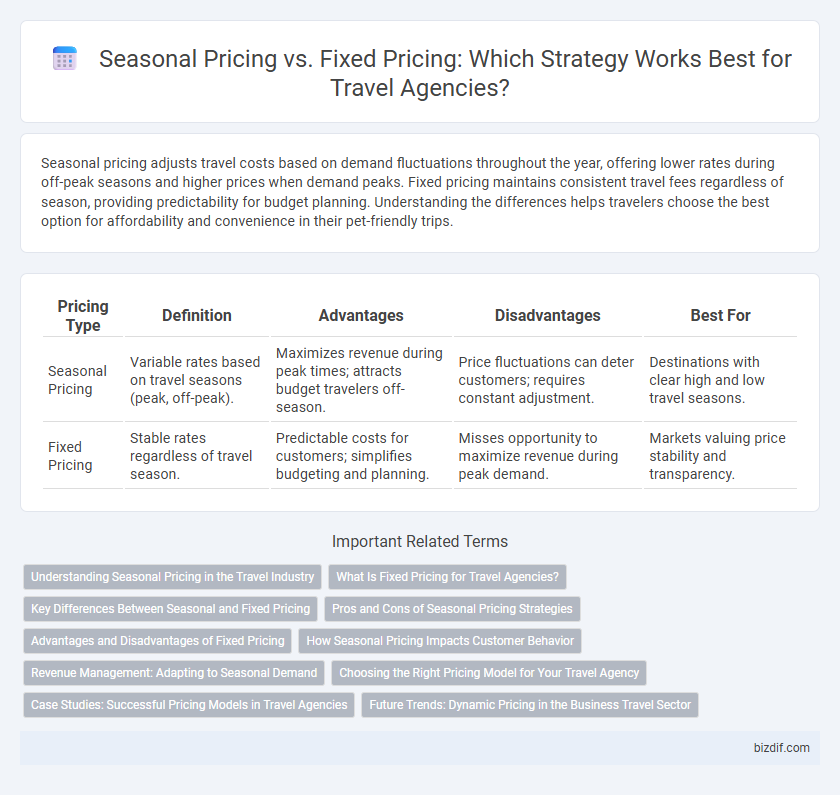Seasonal pricing adjusts travel costs based on demand fluctuations throughout the year, offering lower rates during off-peak seasons and higher prices when demand peaks. Fixed pricing maintains consistent travel fees regardless of season, providing predictability for budget planning. Understanding the differences helps travelers choose the best option for affordability and convenience in their pet-friendly trips.
Table of Comparison
| Pricing Type | Definition | Advantages | Disadvantages | Best For |
|---|---|---|---|---|
| Seasonal Pricing | Variable rates based on travel seasons (peak, off-peak). | Maximizes revenue during peak times; attracts budget travelers off-season. | Price fluctuations can deter customers; requires constant adjustment. | Destinations with clear high and low travel seasons. |
| Fixed Pricing | Stable rates regardless of travel season. | Predictable costs for customers; simplifies budgeting and planning. | Misses opportunity to maximize revenue during peak demand. | Markets valuing price stability and transparency. |
Understanding Seasonal Pricing in the Travel Industry
Seasonal pricing in the travel industry adjusts rates based on demand fluctuations during peak and off-peak seasons, allowing agencies to maximize revenue and manage capacity efficiently. Travelers encounter higher prices during holidays or popular vacation periods, reflecting increased demand and limited availability. Understanding seasonal pricing helps customers plan trips strategically, securing better deals by booking during off-peak months or shoulder seasons.
What Is Fixed Pricing for Travel Agencies?
Fixed pricing for travel agencies involves setting a constant rate for services such as tours, accommodations, and transportation regardless of demand fluctuations or seasonality. This pricing strategy simplifies budgeting for customers and ensures consistent revenue streams for agencies by avoiding price changes tied to peak travel periods or low seasons. Fixed pricing often attracts travelers seeking predictable costs and long-term planning options, contrasting with seasonal pricing where prices vary based on travel demand and time of year.
Key Differences Between Seasonal and Fixed Pricing
Seasonal pricing in travel agencies fluctuates based on demand, holidays, and peak vacation periods, allowing for dynamic rate adjustments that maximize revenue during high-demand seasons. Fixed pricing offers stable, consistent rates year-round, providing customers with predictability and simplifying budgeting for trips regardless of travel dates. Key differences include pricing flexibility, revenue management strategies, and customer perception of value, with seasonal pricing catering to market trends and fixed pricing emphasizing simplicity and transparency.
Pros and Cons of Seasonal Pricing Strategies
Seasonal pricing strategies in travel agencies allow for dynamic adjustment of rates based on peak demand periods, maximizing revenue during high season while attracting budget-conscious travelers in off-peak times. This approach can enhance occupancy rates and profit margins but may confuse or deter customers seeking price consistency and predictability. However, implementing seasonal pricing requires sophisticated data analysis and market insight to avoid alienating loyal customers with fluctuating prices.
Advantages and Disadvantages of Fixed Pricing
Fixed pricing in travel agencies offers transparency and predictability, allowing customers to plan their trips without worrying about sudden cost changes. It simplifies budgeting by providing a consistent rate regardless of demand fluctuations, which can enhance customer trust and satisfaction. However, fixed pricing may limit revenue potential during peak seasons and reduce flexibility in responding to market dynamics or competitive pricing strategies.
How Seasonal Pricing Impacts Customer Behavior
Seasonal pricing directly influences customer booking patterns by encouraging travelers to plan trips during off-peak periods to secure lower rates, leading to fluctuating demand throughout the year. This dynamic pricing strategy often increases perceived value during high-demand seasons, motivating early reservations and boosting customer urgency. Consequently, travel agencies using seasonal pricing can better manage inventory and maximize revenue by aligning prices with customer behavior and seasonal travel trends.
Revenue Management: Adapting to Seasonal Demand
Seasonal pricing adjusts travel package rates based on fluctuating demand during peak and off-peak seasons, maximizing revenue by capitalizing on high-demand periods. Fixed pricing simplifies budgeting for travelers but can lead to missed opportunities for revenue optimization during seasonal spikes. Effective revenue management in travel agencies leverages dynamic pricing strategies aligned with seasonal trends to enhance profitability and market competitiveness.
Choosing the Right Pricing Model for Your Travel Agency
Choosing the right pricing model for your travel agency depends on market demand, customer preferences, and competitive analysis. Seasonal pricing maximizes revenue during peak travel times by adjusting rates based on demand fluctuations, while fixed pricing ensures consistent income and straightforward budgeting throughout the year. Travel agencies focusing on niche markets or fluctuating destinations often benefit from seasonal pricing, whereas those targeting long-term contracts or package deals may prefer fixed pricing for stability.
Case Studies: Successful Pricing Models in Travel Agencies
Case studies reveal that travel agencies adopting seasonal pricing models achieve higher revenue by aligning prices with demand fluctuations during peak and off-peak travel periods. Fixed pricing models provide consistent pricing that fosters customer trust and simplifies budgeting but may limit profit maximization during high-demand seasons. Agencies combining dynamic seasonal adjustments with transparent communication demonstrate balanced profitability and customer satisfaction.
Future Trends: Dynamic Pricing in the Business Travel Sector
Future trends in the business travel sector emphasize dynamic pricing models that adjust rates based on real-time demand, seasonality, and customer booking behavior, outperforming traditional fixed pricing structures. Advanced algorithms and AI-driven analytics enable travel agencies to optimize revenue by offering personalized, flexible pricing tailored to individual corporate clients' needs. This shift to dynamic pricing enhances competitiveness and maximizes profitability in an increasingly data-driven travel market.
Seasonal pricing vs Fixed pricing Infographic

 bizdif.com
bizdif.com